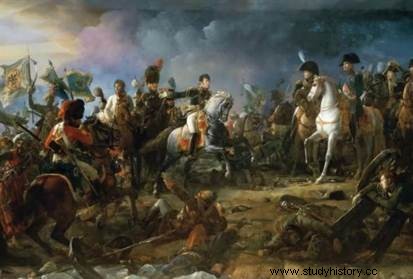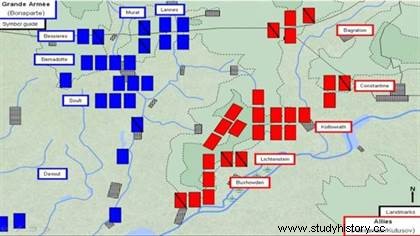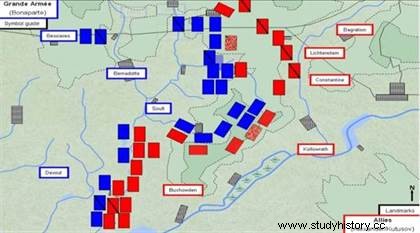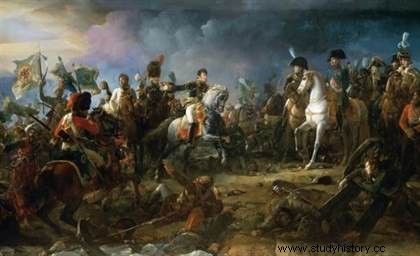 The Battle of Austerlitz took place on December 2, 1805 and pitted the troops of Emperor Napoleon I against the armies of the Russian (Alexander I) and Austrian (Francis II) emperors. Also known as the Battle of the Three Emperors, this crushing French victory on the anniversary of the Emperor's coronation erased the naval disaster at Trafalgar and brought the War of the Third Coalition to a successful conclusion. Napoleon never created, among his marshals, a duke or a prince of Austerlitz:it was his personal victory, and a formidable instrument of legitimacy to his power. The next day, the Emperor addressed his army:"Soldiers, I am happy with you... All you have to do is say:I was at the Battle of Austerlitz, for the response:There you go. a brave man! »
The Battle of Austerlitz took place on December 2, 1805 and pitted the troops of Emperor Napoleon I against the armies of the Russian (Alexander I) and Austrian (Francis II) emperors. Also known as the Battle of the Three Emperors, this crushing French victory on the anniversary of the Emperor's coronation erased the naval disaster at Trafalgar and brought the War of the Third Coalition to a successful conclusion. Napoleon never created, among his marshals, a duke or a prince of Austerlitz:it was his personal victory, and a formidable instrument of legitimacy to his power. The next day, the Emperor addressed his army:"Soldiers, I am happy with you... All you have to do is say:I was at the Battle of Austerlitz, for the response:There you go. a brave man! »
Where did the Battle of Austerlitz take place?
The battlefield of Austerlitz is located about ten kilometers southeast of Brünn , capital of Moravia then Austrian province. It was in 1805 a rural area, located between the wooded slopes of the Moravian hills and the marshy course of the Schwarzawa. After capturing the main Austrian army at Ulm five weeks earlier, Napoleon had been brought to this region, located north of Vienna, by the pursuit of what remained of the forces of the Emperor Francis II of the Holy Empire . The latter had indeed given up defending his capital to meet his Russian counterpart Alexander I , the other main animator of the coalition who, at the instigation of England , was formed against Napoleonic France.
Let's remember some figures that allow us to resituate the scale of the battle:Austerlitz was an engagement of a big half-dozen hours , involving some 160,000 soldiers (approximately 75,000 French , opposed to 60,000 Russians and 25,000 Austrians ) on a battlefield not exceeding, like most of those of the time, 150 km² . In barely a quarter of a day, it cost the victors 9,000 killed, wounded and prisoners , and to the vanquished, 27,000 . Even victory is written in letters of blood, with 1,300 killed and 7,000 wounded on the French side.
Preparations
On the evening of December 1, 1805, the positions of the French army southeast of Brünn offered an unusual sight. In the center and on the left, on the road that connects Brünn to Olmutz, the French are present in force, because it is from there that the arrival of the Austro-Russian army is expected. But further south, the right wing of the French army is completely stripped, and very stretched . This is problematic, to say the least, because if the Allies manage to break it, they can cut the Brünn-Vienna road, isolating the rest of the Grande Armée from its supply lines. Napoleon is perfectly aware of this, and has just recalled the IIIrd army corps of Marshal Davout , which arrives from Vienna by forced march.
 In reality, this gross tactical error was perfectly deliberate on the part of the French Emperor. It's a trap :he wants to invite his enemies to attack his right wing. Engaging along the swamps bordering the southern edge of the battlefield, these would then present him with their own right flank, leaving them vulnerable to attack from the French center. This feint, often celebrated as the supreme expression of Napoleon I's military genius, is well known.
In reality, this gross tactical error was perfectly deliberate on the part of the French Emperor. It's a trap :he wants to invite his enemies to attack his right wing. Engaging along the swamps bordering the southern edge of the battlefield, these would then present him with their own right flank, leaving them vulnerable to attack from the French center. This feint, often celebrated as the supreme expression of Napoleon I's military genius, is well known.
What is a little less so is the poisoning campaign which encompasses it. Because since he occupied Vienna, the Emperor of the French has been conscientiously trying to make the Allies believe that he is weaker than he really is. Leaving Davout's 7,000 men in Vienna, far from the rest of the army, is also part of this more general logic.
A strategic choice largely dictated by circumstances, moreover. Neutral until then, the Prussians began to stir; if they joined the coalition, they would pose a serious threat to supply lines that had become overstretched. And then, fall is already very advanced and winter is fast approaching. If he does not win a decisive victory quickly, Napoleon will be forced to wait until the following spring to win the decision, with the risk of losing the initiative and seeing his enemies grow stronger.
So he does everything possible to incite the Austro-Russians to attack him. And his plan ends up working:Tsar Alexander and most of his generals are eager to fight, despite the advice of caution given by Emperor Francis and Russian Marshal Mikhail Kutuzov , yet theoretically the commander-in-chief. They will be completely deceived by the trap set by their adversary, their plan of attack targeting, as expected by Napoleon, the French right wing. The Austro-Russian left wing will march on the village of Telnitz in four columns preceded by a vanguard, between the marshes and the plateau of Pratzen .
The Sun of Austerlitz:The Battle of the Three Emperors
Return to the satellite image. Looking for Telnitz:Today is Telnice , a village northwest of Satcany and northeast of Menen. In the early morning of December 2, 1805, its garrison was provided by the 3rd line infantry regiment alone. A little further north is Sokolnice . This is Sokolnitz, another objective of the attack, defended only by the 26th Light Infantry Regiment. The castle around which the French unit was deployed is still there. Let's zoom in further:it is to the northeast of the village, now enlarged by a few housing estates and industries.
 The Allies successively attacked the two villages from seven o'clock in the morning. The weather is cold and damp, and the battlefield is shrouded in grayness. One can easily imagine how the approach march of the men of General Buxhövden , responsible for leading the attack against the French right wing, must have been disagreeable. It was all the more difficult as it was particularly badly coordinated. The coalition army did not have the rigorous organization in corps, divisions and brigades of the French army, it was still dark when he left and to top it off, Buxhövden was simply drunk. The return of the 5,000 horsemen of General Liechtenstein , which were to remain in reserve, even caused a traffic jam on the southern slopes of the Pratzen plateau.
The Allies successively attacked the two villages from seven o'clock in the morning. The weather is cold and damp, and the battlefield is shrouded in grayness. One can easily imagine how the approach march of the men of General Buxhövden , responsible for leading the attack against the French right wing, must have been disagreeable. It was all the more difficult as it was particularly badly coordinated. The coalition army did not have the rigorous organization in corps, divisions and brigades of the French army, it was still dark when he left and to top it off, Buxhövden was simply drunk. The return of the 5,000 horsemen of General Liechtenstein , which were to remain in reserve, even caused a traffic jam on the southern slopes of the Pratzen plateau.
Thus, instead of attacking their objectives all together, the vanguard and the four coalition columns did so one after the other, which allowed the French to sustain the initial attack. But very quickly, the weight of numbers will make the difference, and the French are thrown out of Telnitz. They then fall back on the other side of a stream, the Goldbach , whose outline can hardly be guessed on the satellite image:it is the thin line of trees that passes northwest of Telnice and southeast of Sokolnice. But the French right wing was not pierced:Davout's III Army Corps arrived just in time to counter-attack and retake Telnitz. He will be thrown back a little later by a charge of hussars, but the support of the artillery will allow him to recover along the Goldbach.
The timely arrival of Davout's men, yet exhausted after covering 110 kilometers in two days , allows the other defenders (the division of General Louis Friant) to concentrate on Sokolnitz, from which the French, after a good initial resistance, had been driven out by the artillery of the Russian column commanded by, ironically, a French émigré spent in the service of the Tsar, Count Andrault de Langeron. Several times, Sokolnitz changed hands, before a final attack allowed the Russians to win, around nine o'clock. The situation is then critical for the French outnumbered, but they will not have to suffer another attack:the epicenter of the Battle of Austerlitz has just suddenly moved.
The Pratzen Plateau Attack
From Sokolnice let's head to Prace , to North-east. In 1805, it was Pratzen, the small village that gave its name to the gently sloping plateau on which it was built, an eminence that dominates the surrounding valleys by about forty meters. Seen from the sky, today, we can barely guess the slope, only marked, in places, by the bends of the small country roads. With his usual tactical flair, Napoleon understood and announced even before the battle that this would be the key to victory .
 Having "shod" the Austro-Russians at Telnitz and Sokolnitz, around nine o'clock he launched the two most powerful divisions of the IV Corps of Marshal Soult , those of Vandamme and Saint-Hilaire. As the 16,000 French infantry climbed the small valley that can still be seen meandering just west of Prace today, the morning mist finally parted. The “sun of Austerlitz writes his caption there.
Having "shod" the Austro-Russians at Telnitz and Sokolnitz, around nine o'clock he launched the two most powerful divisions of the IV Corps of Marshal Soult , those of Vandamme and Saint-Hilaire. As the 16,000 French infantry climbed the small valley that can still be seen meandering just west of Prace today, the morning mist finally parted. The “sun of Austerlitz writes his caption there.
The Allies finally realize the importance of Pratzen, but it's too late:their marching wing is now almost isolated from the rest of the army, which is running the risk of being wiped out. Now let’s “zoom out” the aerial view:a simple glance is enough to understand that from up there the French guns can bombard the road at leisure (now numbered "416 ”) which goes from Austerlitz to Telnitz and Sokolnitz. Behind it, the swamps , of which we can hardly guess nowadays but the winding course of the Litava, form a deadly trap.
Koutouzov then tries to regain control by a pincer counter-attack:while forces detached from the Telnitz/Sokolnitz will attack from the south, the heavy cavalry of Liechtenstein and the Russian Imperial Guard will attempt to circumvent the left of Soult's army corps, now in an advanced position. A situation that did not escape Napoleon, the Emperor sending in return the army corps of Bernadotte and the cavalry of Murat to cover Soult's left flank. This is the decisive moment of the battle:if the French manage to hold Pratzen, nothing and no one will be able to snatch victory from them.
From the decisive moment to the quarry
 From eleven o'clock, violent infantry and cavalry battles began in the valleys that can still be seen today north of Prace, between Jirikovice and Blazovice . The soldiers of the two camps climb at a run, each on their side, the slopes of the plateau. While Murat takes over the coalition cavalry, Bernadotte has a lot to do with the Russian Guard. After repelling and pursuing the infantry, he must retreat against his cavalry. At this crucial moment, it is his own Guard that the Emperor of the French called in, and his Mamluks finally got the better of Tsar Alexander's regiment of knight-guards.
From eleven o'clock, violent infantry and cavalry battles began in the valleys that can still be seen today north of Prace, between Jirikovice and Blazovice . The soldiers of the two camps climb at a run, each on their side, the slopes of the plateau. While Murat takes over the coalition cavalry, Bernadotte has a lot to do with the Russian Guard. After repelling and pursuing the infantry, he must retreat against his cavalry. At this crucial moment, it is his own Guard that the Emperor of the French called in, and his Mamluks finally got the better of Tsar Alexander's regiment of knight-guards.
Before noon, the fate of the battle is sealed. Kutuzov had no more reservations:Bagration, who was to launch diversionary attacks to draw the attention of the French away from their right wing, was now massively engaged by Lannes' army corps and Murat's cavalry. Despite this, he retreated fighting and in good order along the Brünn-Olmutz road , now numbered “430 on the satellite image and lined with a highway (the “1”), and by which Tsar Alexander, Emperor Francis and their staff will leave the battlefield around one o'clock, all hope being lost. Only Kutuzov will remain, trying to save what can still be saved.
South of the battlefield, the situation is indeed no better for the Allies. The forces tasked with recapturing the Pratzen plateau were no more successful than those of the northern “claw”. Even before meeting the French, they clashed with their comrades, latecomers from the attack on Telnitz and Sokolnitz or fugitives from the Pratzen battle, in a reissue of the previous traffic jam. Those that were not subsequently mowed down by grapeshot that Soult's guns vomited with redoubled blows were shattered by the volleys of muskets French infantry. A single failure was enough to persuade the Austro-Russians that they were wasting their time – and their men – in vain.
Around two o'clock, Napoleon was able to complete his triumph by ordering Soult to advance towards the south, in order to crush the last remnants of the coalition left wing while cutting off its last vehicular retreat - what is now "Highway 416 ". It's the quarry:the vanguard has already been practically annihilated in the fighting around Telnitz, and the two remaining columns, under the orders of Andrault de Langeron and Dokhtorov, have been severely crushed. After an hour and a half, they are nothing more than a disorganized mass of fugitives who try to escape by their last way of salvation:swamps and frozen ponds.
Several thousand of them will remain in French hands. after Austerlitz Others will experience a much less enviable fate. It was during this debacle that a famous, but controversial, episode took place on the frozen pond of Satschan , whose old banks can still be seen today around Satcany. Pounded by French artillery, the ice gave way, engulfing several dozen cannons and the horses to which they were harnessed.
As for the number of drowned soldiers, it is unknown but seems to have been greatly exaggerated later, going up to several thousand according to some. The French, who had the pond drained a few days later to recover the cannons – they were going, together with the other pieces captured that day, to provide the bronze which today constitutes the Vendôme column , in Paris – found there, it seems, only a handful of corpses, without it being known whether others had not already been recovered and buried previously.
Consequences of the Battle of Austerlitz
On the evening of December 2, 1805, the last major Allied army had all but ceased to exist. The anniversary of his coronation , Napoleon I knows another:that of his genius as a strategist and tactician, which enabled him to have and win at Austerlitz the decisive battle he was looking for. Less than a month later, on December 26, the Treaty of Pressburg will seal the end of the War of the Third Coalition. A humiliating peace , which will be worth to François II to lose territories, a colossal war indemnity, and the title of Germanic Emperor, a “Confederation of the Rhine” allied with the French born on the ashes of a now defunct Holy Empire.
But this peace carried within it the seeds of the following two coalitions :that of 1806, Prussia embarrassed by the French stranglehold on Germany joining Russia and England; then that of 1809, with an Austria which will try, in vain, to take its revenge.
Bibliography
- From Jacques Garnier, and Jean Tulard, Austerlitz:December 2, 1805. Fayard Editions, 2005.
- By Pierre Miquel, Austerlitz. Albin Michel, 2005.
- Historical Atlas of the Napoleonic epic. Seine, 2009.
To go further
- Austerlitz by Abel Gance, DVD, Studio canal, 2008.
